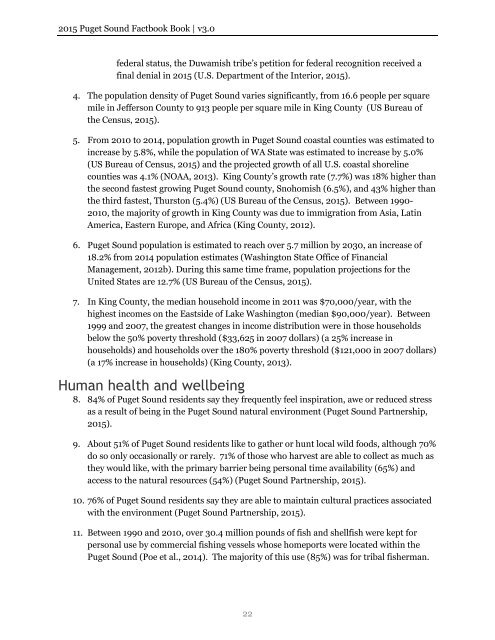You also want an ePaper? Increase the reach of your titles
YUMPU automatically turns print PDFs into web optimized ePapers that Google loves.
2015 <strong>Puget</strong> <strong>Sound</strong> Factbook Book | v3.0<br />
federal status, <strong>the</strong> Duwamish tribe’s petition for federal recognition received a<br />
final denial in 2015 (U.S. Department of <strong>the</strong> Interior, 2015).<br />
4. The population density of <strong>Puget</strong> <strong>Sound</strong> varies significantly, from 16.6 people per square<br />
mile in Jefferson County to 913 people per square mile in King County (US Bureau of<br />
<strong>the</strong> Census, 2015).<br />
5. From 2010 to 2014, population growth in <strong>Puget</strong> <strong>Sound</strong> coastal counties was estimated to<br />
increase by 5.8%, while <strong>the</strong> population of WA State was estimated to increase by 5.0%<br />
(US Bureau of Census, 2015) and <strong>the</strong> projected growth of all U.S. coastal shoreline<br />
counties was 4.1% (NOAA, 2013). King County’s growth rate (7.7%) was 18% higher than<br />
<strong>the</strong> second fastest growing <strong>Puget</strong> <strong>Sound</strong> county, Snohomish (6.5%), and 43% higher than<br />
<strong>the</strong> third fastest, Thurston (5.4%) (US Bureau of <strong>the</strong> Census, 2015). Between 1990-<br />
2010, <strong>the</strong> majority of growth in King County was due to immigration from Asia, Latin<br />
America, Eastern Europe, and Africa (King County, 2012).<br />
6. <strong>Puget</strong> <strong>Sound</strong> population is estimated to reach over 5.7 million by 2030, an increase of<br />
18.2% from 2014 population estimates (Washington State Office of Financial<br />
Management, 2012b). During this same time frame, population projections for <strong>the</strong><br />
United States are 12.7% (US Bureau of <strong>the</strong> Census, 2015).<br />
7. In King County, <strong>the</strong> median household income in 2011 was $70,000/year, with <strong>the</strong><br />
highest incomes on <strong>the</strong> Eastside of Lake Washington (median $90,000/year). Between<br />
1999 and 2007, <strong>the</strong> greatest changes in income distribution were in those households<br />
below <strong>the</strong> 50% poverty threshold ($33,625 in 2007 dollars) (a 25% increase in<br />
households) and households over <strong>the</strong> 180% poverty threshold ($121,000 in 2007 dollars)<br />
(a 17% increase in households) (King County, 2013).<br />
Human health and wellbeing<br />
8. 84% of <strong>Puget</strong> <strong>Sound</strong> residents say <strong>the</strong>y frequently feel inspiration, awe or reduced stress<br />
as a result of being in <strong>the</strong> <strong>Puget</strong> <strong>Sound</strong> natural environment (<strong>Puget</strong> <strong>Sound</strong> Partnership,<br />
2015).<br />
9. <strong>About</strong> 51% of <strong>Puget</strong> <strong>Sound</strong> residents like to ga<strong>the</strong>r or hunt local wild foods, although 70%<br />
do so only occasionally or rarely. 71% of those who harvest are able to collect as much as<br />
<strong>the</strong>y would like, with <strong>the</strong> primary barrier being personal time availability (65%) and<br />
access to <strong>the</strong> natural resources (54%) (<strong>Puget</strong> <strong>Sound</strong> Partnership, 2015).<br />
10. 76% of <strong>Puget</strong> <strong>Sound</strong> residents say <strong>the</strong>y are able to maintain cultural practices associated<br />
with <strong>the</strong> environment (<strong>Puget</strong> <strong>Sound</strong> Partnership, 2015).<br />
11. Between 1990 and 2010, over 30.4 million pounds of fish and shellfish were kept for<br />
personal use by commercial fishing vessels whose homeports were located within <strong>the</strong><br />
<strong>Puget</strong> <strong>Sound</strong> (Poe et al., 2014). The majority of this use (85%) was for tribal fisherman.<br />
22


